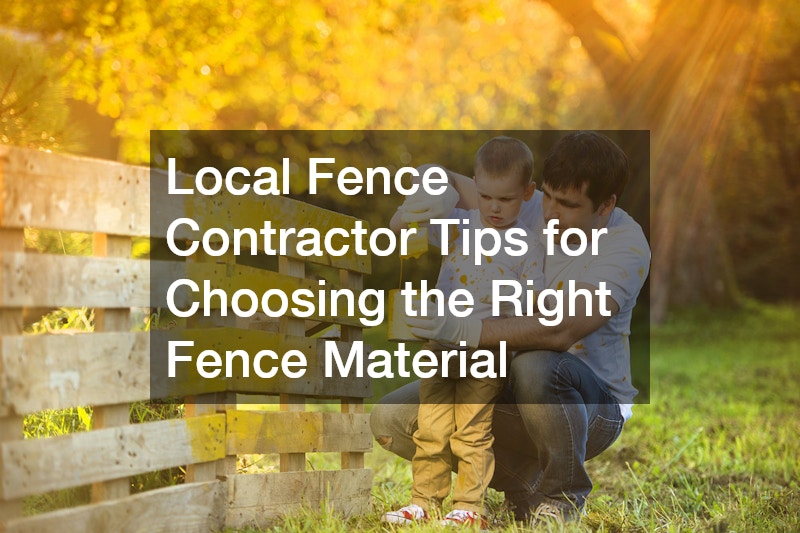Choosing the right fence material can significantly influence the appearance, durability, and functionality of your property’s fencing. This article provides insights and tips from local fence contractors to help you make an informed decision. With various options available, including wood, vinyl, aluminum, and chain-link, understanding the unique characteristics of each material is crucial.
The goal is to not only find a fence that compliments your aesthetic preference but also one that is practical for your specific needs.
What Are the Most Common Types of Fence Materials?
When considering fencing options, wood is one of the most popular choices among homeowners. It offers a classic look and can easily be customized to fit diverse designs and styles. However, wood requires regular maintenance to prevent rotting and pest infestations.
Vinyl fencing has gained popularity due to its low maintenance and durability. Resistant to weather and UV damage, it maintains its color and structure longer than many wood varieties. This makes vinyl a cost-effective solution over time, despite its higher initial cost.
Aluminum fencing provides a sleek and modern look, often employed in decorative applications. It is lightweight, rust-resistant, and available in various styles and colors. Although it doesn’t offer the same level of privacy as wood or vinyl, it can be an excellent choice for pool areas or ornamental gardens.
How Do I Determine the Right Fence Material for My Climate?
Climate plays a significant role in how long your fence will last and how much maintenance it will require. For instance, areas with high humidity are not ideal for untreated wood, which can swell, warp, or rot over time. Homeowners in such regions should look for moisture-resistant options.
If you live in a region with extreme temperatures, aluminum or vinyl may provide better longevity than wood, which could crack or split under harsh conditions. Selecting a material suited to your local climate can save you money on replacements and repairs.
Consulting with local fence contractors can provide insight into which materials perform best in your area’s specific weather conditions. They can also guide you on protective treatments and installation techniques to enhance durability.
What Is the Budget I Should Expect for Different Fence Materials?
When calculating your fencing budget, it’s essential to look beyond just the initial material costs. Installation expenses can vary widely based on the complexity of the project and local labor rates. Therefore, establishing a comprehensive budget will deliver better long-term satisfaction.
Long-term maintenance costs also significantly influence the overall financial commitment to a fencing project. For example, while wood might have a lower upfront cost, the expenditure on treatment, staining, and repairs should be factored in. Vinyl, while initially higher, often requires less upkeep, which can offset its initial price over time.
Additional features, such as gates or decorative elements, should also be included in your budget considerations. Understanding the full scope of what’s involved in both installation and ongoing care will help you make a sound investment in your home’s fencing.
How Do I Assess the Durability of a Fence Material?
Durability is a critical factor to consider when selecting fence material, as it directly affects how often you will need to repair or replace it. Start by examining the lifespan of each material under typical usage conditions, keeping in mind that this may vary based on local climate and soil conditions.
Conducting research on materials’ resistance to common issues such as pests, decay, and UV damage can guide you in choosing the right option. For instance, composite materials may provide superior durability compared to standard wood fences.
Another aspect to consider is warranties offered by manufacturers. A longer warranty period generally indicates a higher confidence in the product’s durability. Discussing these points with your local fence contractor can provide valuable insights into the best durable choices for your home.
What Aesthetic Considerations Should I Keep in Mind?
When choosing a fence material, aesthetics are as crucial as functionality. Consider the architectural style of your home; for example, a modern home might benefit from sleek aluminum, while a traditional home may look best with wooden slats for historical authenticity.
Color and finish are also important elements that contribute to your home’s exterior appeal. Darker colors often stand out against green landscapes, whereas lighter colors can add warmth and blend seamlessly with surrounding foliage.
Collaborating with local fence contractors can aid in visualizing how different materials will look in your yard. Many contractors can provide samples or mock-ups to ensure that your chosen fence will complement your landscaping beautifully.
Choosing the right fence material requires careful consideration of various factors, including functionality, budget, durability, and aesthetics. Each option has different characteristics that can impact your home’s value and visual appeal. Consulting with local fence contractors can provide additional insights and help you make the best choice for your property.


